Comics Timeline

The history of the funnies in America
by Shmuel Ross and Jennie Wood
1895 | 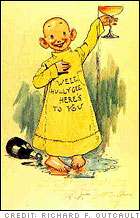 The New York World, owned by Joseph Pulitzer, begins publishing a series of comics by Richard Outcault taking place in Hogan's Alley, and featuring a boy in a yellow nightshirt who becomes known as "The Yellow Kid." The Yellow Kid becomes very popular in New York City, and, in 1897, William Hearst's New York Journal hires Oucault to draw the cartoon for them instead. Pulitzer responds by hiring George Luks to draw his own version of The Yellow Kid. Both strips end in 1898. (As a side note, both the World and the Journal were known for sensationalism, each trying to top the other with more interesting stories, rather than sticking to reporting the facts. This practice has become known as "yellow journalism.") |
1897 | Rudolph Dirks's The Katzenjammer Kids appears for the first time in the New York Journal on December 12. It stars a set of twin brothers, Hans and Fritz, and is the first strip to tell a story in a series of panels. It is still running today, as the oldest strip in syndication. The first comic-strip reprint collection, The Yellow Kid in McFadden's Flats, is published as a 196-page hardcover book. Top |
1905 | Little Nemo in Slumberland, by Winsor McCay, begins running in the New York Herald. The first comic with a continuing story, it is still noted as one of the most richly illustrated comic strips of all time. |
1907 | Mutt and Jeff becomes the first successful daily comic strip. Originally known as A. Mutt, Jeff joins the cast the following year. In addition to being a newspaper strip, it gets made into a series of animated films starting in 1913. The strip continues to be published through 1982. |
1913 | 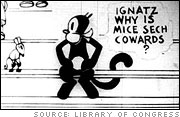 Krazy Kat, which originated as filler drawings at the bottom of The Dingbat Family, is spun off into its own strip by writer and artist George Herriman. Starring Ignatz Mouse, Krazy Kat, and Offissa Pup, the strip is never very popular, but has a small and devoted following. Fortunately, this following includes William Randolph Hearst, who owns King Features Syndicate, which carries the strip until Herriman's death in 1944. Top |
1914 | The first of Rube Goldberg's ridiculously complicated contraptions, the "Automatic Weight Reducing Machine," is published in the New York Evening Mail. |
1919 | Frank King's Gasoline Alley begins. It is the first strip ever to have characters who age in real time. Characters go to war, marry, have children, and so on. The strip is still running today. |
1920 | Winnie Winkle debuts, chronicling the trials of a woman working to support her family. While not the first comic to feature a working woman, it is the first to gain widespread attention. It lasts until 1996. |
1924 | Harold Gray begins Little Orphan Annie, a tale of rags to riches... to rags, to riches, and back again, as the indomitable orphan and millionaire Daddy Warbucks find each other and part over and over. Annie also finds success as a radio show, a Broadway musical, and a movie. Top |
| 1930 | Chic Young begins Blondie. She marries Dagwood in 1933. In an unprecedented set of crossovers in 2005, dozens of comic strips join in celebrating its 75 years in print. |
1933 | Funnies on Parade, a collection of reprinted newspaper comic strips, is given away as an advertising promotion. It is the first to be printed in what becomes the standard size for modern comic books: 5.5" x 8". It's followed by Famous Funnies, a similar collection sold for ten cents. |
1934 | Milton Caniff's Terry and the Pirates begins. The popular strip features the adventures of Terry Lee in the Far East. |
1937 | The first issue of Detective Comics is released by the company that will eventually be named DC Comics. (DC is an abbreviation for "Detective Comics.") Top |
1938 | 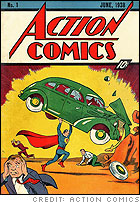 Action Comics makes its first appearance, and features the first superhero ever: Superman. He can run faster than a train, leap over tall buildings, and block bullets with his chest, but isn't yet able to fly. The character is a hit, and many more superhero comics follow. |
1939 | "The Bat-Man" makes his first appearance in Detective Comics. Unlike Superman, Batman has no powers; he fights crime using martial arts, technology, and his mind. Timely Comics releases Marvel Comics, including Prince Namor the Sub-Mariner and several other heroes. Timely will eventually be renamed Marvel. DC introduces The Flash, a superhero who can run faster than the speed of light. |
1940 | DC presents Alan Scott, who makes a ring that allows him to use the light of the Green Lantern. Brenda Starr debuts. The star of the strip is a redheaded reporter who often visits exotic places. It's notable for being created by a woman, Dale Messick. The strip continues to be female-created, now being written by Mary Schmich and drawn by June Brigman. |
1941 | In what will become the Marvel universe, Steve Rogers is given super-soldier serum and a mighty shield, becoming Captain America. DC introduces Wonder Woman, designed by psychiatrist William Marston to embody female ideals of heroism. Redheaded teenager Archie Andrews makes his first appearance in Pep Comics. In 1945, the publisher will change its name from MLJ Comics to Archie Comics. Top |
1947 | Donald Duck's Uncle Scrooge makes his first comic book appearance. |
1948 |  Walt Kelly starts the daily Pogo comic strip. The Pogo Possum character had been introduced in the first issue of the Animal Comics comic book in 1941, but gained fame for his topical political humor in the newspaper strips. |
1949 | Casper, the Friendly Ghost, gets his own comic book. He'd been introduced in a cartoon in 1945. |
1950 | Charles M. Schulz's Peanuts, the most profitable comic strip of all time, begins its 50-year run. He'd wanted to name it Li'l Folks, but the United Feature syndicate changed its name over Schulz's objections. Spinoffs of the comic, which features Charlie Brown and Snoopy, will include many animated TV specials and a Broadway musical, not to mention every imaginable merchandising tie-in. The strip ends the day Schulz dies, but newspapers continue to reprint the older installments. Top |
1954 | In response to public and Congressional objections to comic books featuring tales of crime and horror, the Comics Code Authority is created. |
1959 | DC Comics introduces Supergirl, cousin of Superman. |
1961 | Marvel presents Stan Lee's The Fantastic Four, a superhero group consisting of Mr. Fantastic, The Invisible Girl, The Thing, and The Human Torch. Unusually, the team members didn't hide their real identities (Reed Richards, Susan Storm, Ben Grimm, and Johnny Storm). Reed and Susan would marry in 1965. |
1962 | 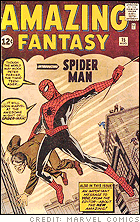 Marvel adds another two superheroes: Spider-Man and The Hulk. Bitten by a radioactive spider, Peter Parker gains the proportionate strength of a spider, and designs his own webshooters. He soon learns that with great power comes great responsibility. Dr. Banner, belted by gamma rays, turns into the Hulk, a giant green monster with matching purple pants. Archie Comics debuts Sabrina, the Teenage Witch in the back of Archie's Madhouse. She'll get her own title in 1971, eventually starring in several cartoon shows and a live-action TV series. Top |
1963 | Josie McCoy is introduced by Archie Comics in She's Josie. In 1969, she'll become the head of a rock band, in Josie and the Pussycats. Marvel Comics starts its first series of mutants, the X-Men, led by Professor X. The other founding members are Angel, Beast, Cyclops, Marvel Girl, and Iceman. |
1964 | Daredevil, the Man Without Fear, appears in his own Marvel Comics title. This superhero was blinded by radioactive waste, which heightened his other senses. In the DC universe, the Teen Titans makes its first appearance, consisting of Aqualad, Kid Flash, Robin, and Wonder Girl. |
1968 | Ziggy is created by Tom Wilson, an executive at the American Greetings card company. He'll get his own daily newspaper panel in 1971. |
1970 | 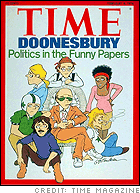 Garry Trudeau's Doonesbury begins appearing in daily newspapers, the first strip to be carried by Universal Press Syndicate. The strip combines the ongoing stories of various characters aging in real time with political satire, and would become the first comic strip to be awarded the Pulitzer Prize for Editorial Cartooning, in 1975. Top |
1974 | SNXXT! Wolverine makes his first appearance, as a Canadian superhero fought by the Hulk. He'll later join the X-Men and get his own monthy title. |
1976 | Cathy Guisewite introduces Cathy, a comic strip loosely based on her own life. The Everywoman main character struggles with "the four basic guilt groups: Food, Love, Mother, and Career." |
1978 | Garfield begins his long nap in the nation's newspapers. The strip becomes one of the most widely syndicated—and merchandised—of all time. |
1979 | The For Better or For Worse comic strip debuts, telling the story of the Patterson family. The characters age in real time, and the strip becomes known for its realistic portrayal of life events. Lynn Johnston's creation will eventually be nominated for a Pulitzer, a rare distinction for any comic strip, but especially for a non-political one. Top |
1980 | The Far Side, a strange but popular daily panel, makes its first appearance in the San Francisco Chronicle on New Year's Day. Bloom County begins in December. While modeled on Doonesbury to some extent, the strip has a wackier tone and includes talking animals. Its two most famous characters are Opus the penguin and Bill the Cat. (Ironically, Bill—specifically created as an unmerchandisable parody of Garfield—turns out to be highly mechandisable himself.) The strip wins a Pulitzer in 1987. |
| 1984 | A consistently cheerful comic about everyday life, Pat Brady's Rose Is Rose begins its run in syndication. It often shifts to fanciful—sometimes surreal—points of view. |
1985 | 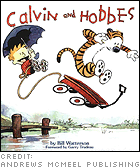 Calvin and Hobbes, the adventures of an imaginative boy and his stuffed tiger, begins its daily newspaper run. Author Bill Watterson becomes known for his refusal to merchandise the wildly popular characters in any way, and for insisting —in later years—that the Sunday strips be run in his preferred format or not at all. While the strip ends in 1996, it is still rerun in many papers. |
1986 | The very first version of Maus, Art Spiegelman's story based on his father's Holocaust experiences, appeared on three pages of Funny Aminals in 1972. It got underway in earnest in 1980, when a 10-page installment appeared in Raw magazine. In 1986, the revised first six installments are published as a graphic novel: Maus: A Survivor's Tale. A second volume is published in 1991 as Maus II: And Here My Troubles Began. The combined work wins a special Pulitzer Prize. In addition to being a powerful story, Maus helps graphic novels begin to gain respectability among mainstream readers and critics. Top |
1987 | Greg Evans' Luann appears on the comic pages, chronicling the life of teenager Luann DeGroot. While a lighthearted strip in general, it's addressed heavy topics such as drugs, drunk driving, and cancer. It's also the first strip ever to feature a character getting her first period. |
1988 | FoxTrot, Bill Amend's comic strip about the Fox family, begins. |
1989 | Neil Gaiman begins The Sandman, published by DC Comics. Along with Swamp Thing, it is used to launch the Vertigo line of comics aimed at adults. The popular and complex series runs for 75 issues, with the occasional followup miniseries or graphic novel. |
1990 | Baby Blues debuts with the birth of Zoe MacPherson to parents Wanda and Darryl. The comic strip, about the ups and downs of child-rearing, is written by Rick Kirkman and Jerry Scott. Characters in the strip age one year for every two or three that pass in real life. Top |
1995 | 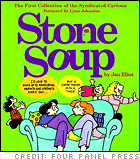 Stone Soup begins to be served. Jan Eliot's strip is one of the few to be centered around a single mother, Val Stone. A widow and full-time worker, Val has two children, Holly and Alix (aged 13 and 9). At the start of the strip, she lives with her mother, and her sister, a divorcé with a toddler, Max. While the characters don't age, Joan eventually marries their next door neighbor, Wally, who's taken in his teenaged nephew, Andy. |
1997 | Jerry Scott and Jim Borgman begin Zits, a strip about the family and friends of 15-year-old Jeremy Duncan. It makes frequent use of surreal imagery reflecting and exaggerating characters' points of view. |
1999 | The Boondocks, by Aaron McGruder, begins syndication in more than 150 newspapers. The strip stars African American children in a mostly white area. Its bitingly satirical commentary on racial and political issues has earned it both praise and protests. |
2001 | Pearls Before Swine, which has been published on the Web since 1999, begins appearing in newspapers on December 31. The strip, written by Stephan Pastis, features Pig, Rat, Zebra, Goat, and The Fraternity of Crocodiles. The characters are aware that they're in a comic strip, one which often parodies other strips and the medium itself. The simplistic art style plays off a quickwitted and quirky comic sensibility. Top |
2002 | The first American edition of Shonen Jump, dated January 2003, is released the preceding December. This 288-page digest of Japanese comic books, or manga, includes installments of Yu-Gi-Oh! and One Piece. The first issue sells almost 300,000 copies, a definite success, and another installment follows each month thereafter. The magazine is a spinoff of Japan's Weekly Shonen Jump, which has been running since 1968. Pages in the American edition are read "backward," from right to left, so that the artwork appears as it did in the original Japanese version. |
2005 | The publishers of Shonen Jump introduce Shojo Beat, a manga digest targeted at older teens, particularly teenaged girls. ("Shonen" means "boy," and "shojo" means "girl.") The tagline is "Manga from the heart." Top |
2007 | Captain America is shot and killed by his nemesis, Red Skull. Top |
2008 | Howard Zinn — political scientist, historian, and social critic — releases a graphic novel titled A People's History of American Empire. It is based on Zinn's classic book A People's History of the United States. The graphic novel was illustrated by Mike Konopacki. Iron Man, starring Robert Downey, Jr., and based on the Marvel comic of the same name, is released in theaters to much critical acclaim. The Dark Knight, the sequel to Batman Begins, breaks box-office records during its opening weekend with $155.41 million. Top |
2009 | Watchmen, the film adaptation of the acclaimed comic book by Alan Moore and Dave Gibbons, is released in theaters. The movie was deemed "unfilmable" after a handful of directors failed to produce the movie in the 1990s. Aside from a few minor alterations, the film remains faithful to the plot of the comic book. The film was directed by Zack Snyder, who gained wide recognition after the release of his film adaptation of 300 in 2007. The Walt Disney Company agrees to buy Marvel Entertainment Inc. (Marvel Comics) for $4 billion dollars. Top |
2010 | Digital comics enter the mainstream, with online readership and apps for comics on the go. According to comicsalliance.com, graphic novel sales fell 20% in 2010, while digital comics sales logged an impressive 1000% increase. Top |
2011 | Thor, a film based on the Marvel Comics character of the same name, is released in May. It ends up eighth on the list of the top ten highest grossing movies of the year with a box office total of more than $181 million. Captain America: The First Avenger comes in at number ten on the list, making $176 million. Top |
2012 | Movies based on comics continue to dominate the box office. Marvel's The Avengers is the top movie of 2012, with a domestic gross of more than $623 million. The Dark Knight Rises comes in second and The Amazing Spider-Man is seventh on the top ten year end list. Top |
2014 | The Guardians of the Galaxy is the top box office movie of the year, with a domestic gross of more than $333 million. Captain American: The Winter Soldier comes in third and X-Men: Days of Future Past is eighth. More comics are adapted for television as well. TV shows such as Marvel's Agents of S.H.I.E.L.D., Gotham, and Constantine are all based on comics. Due to the popularity of the Captain America films and Marvel's Agents of S.H.I.E.L.D., a TV series based on Marvel's Agent Carter is announced. It will air in 2015. Top |
Related Links |
- More Timelines







